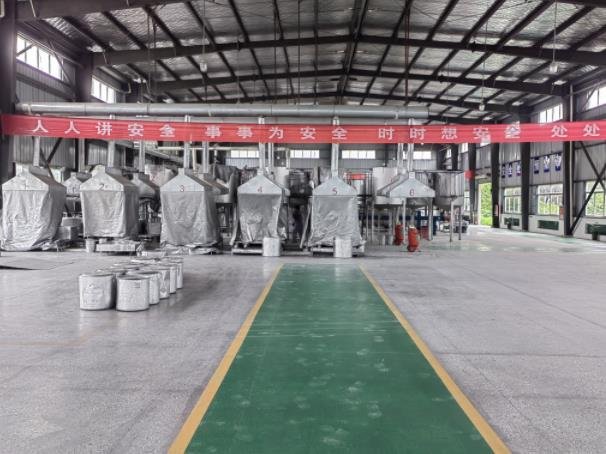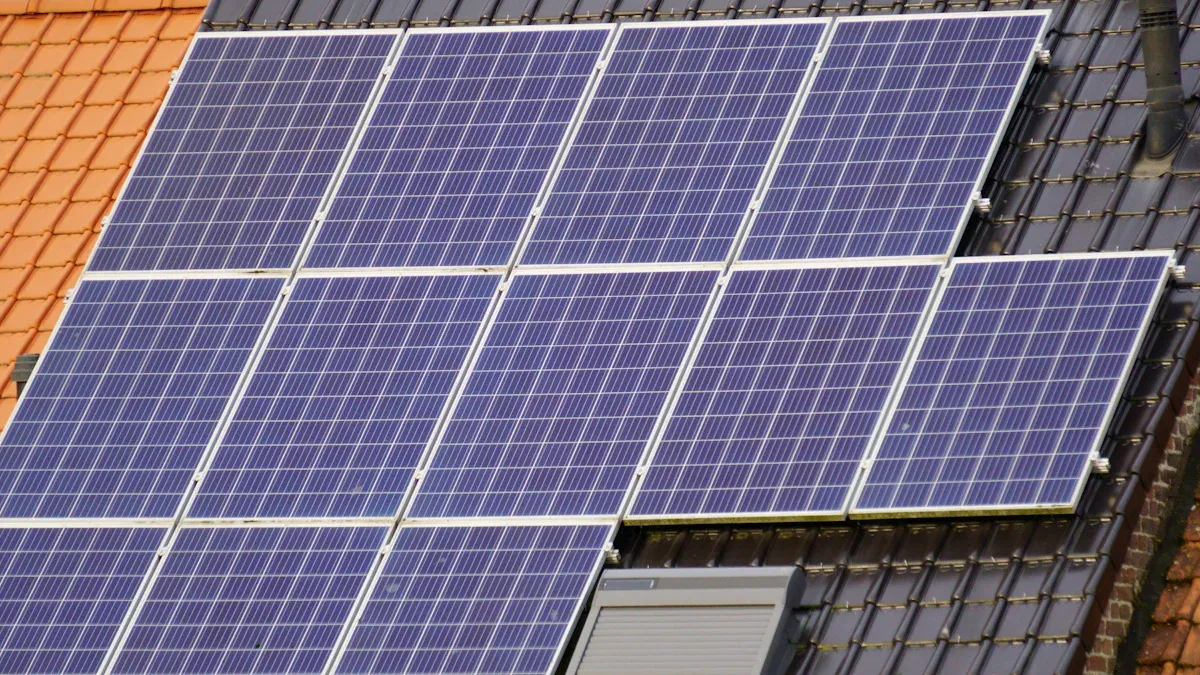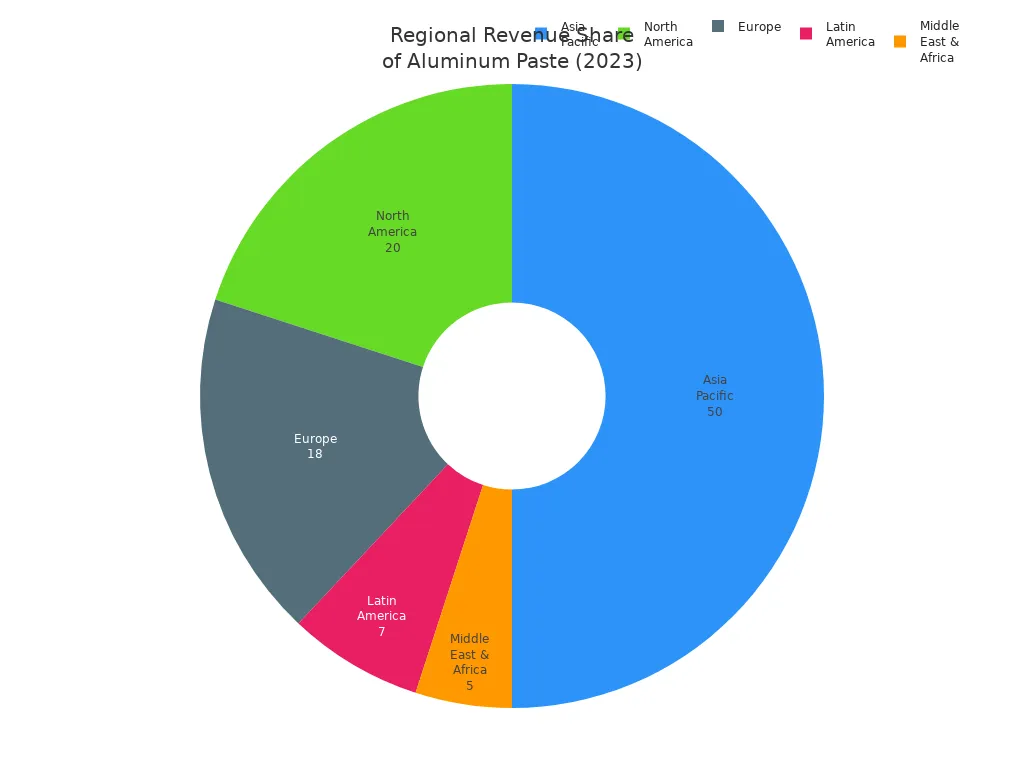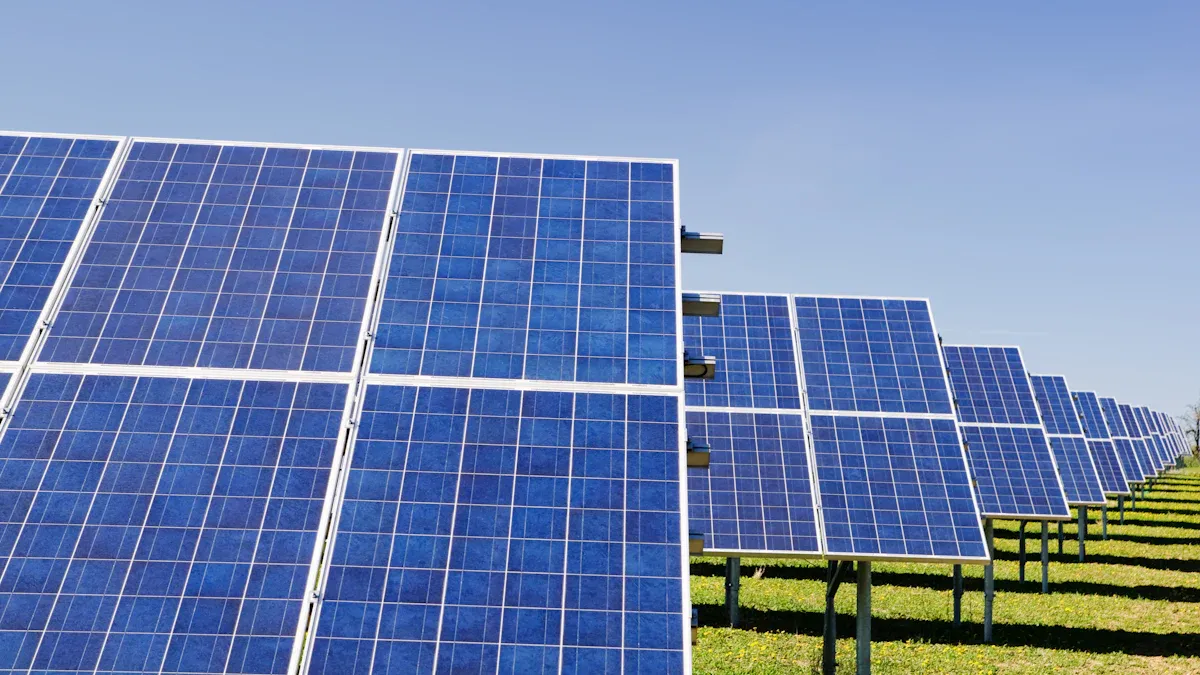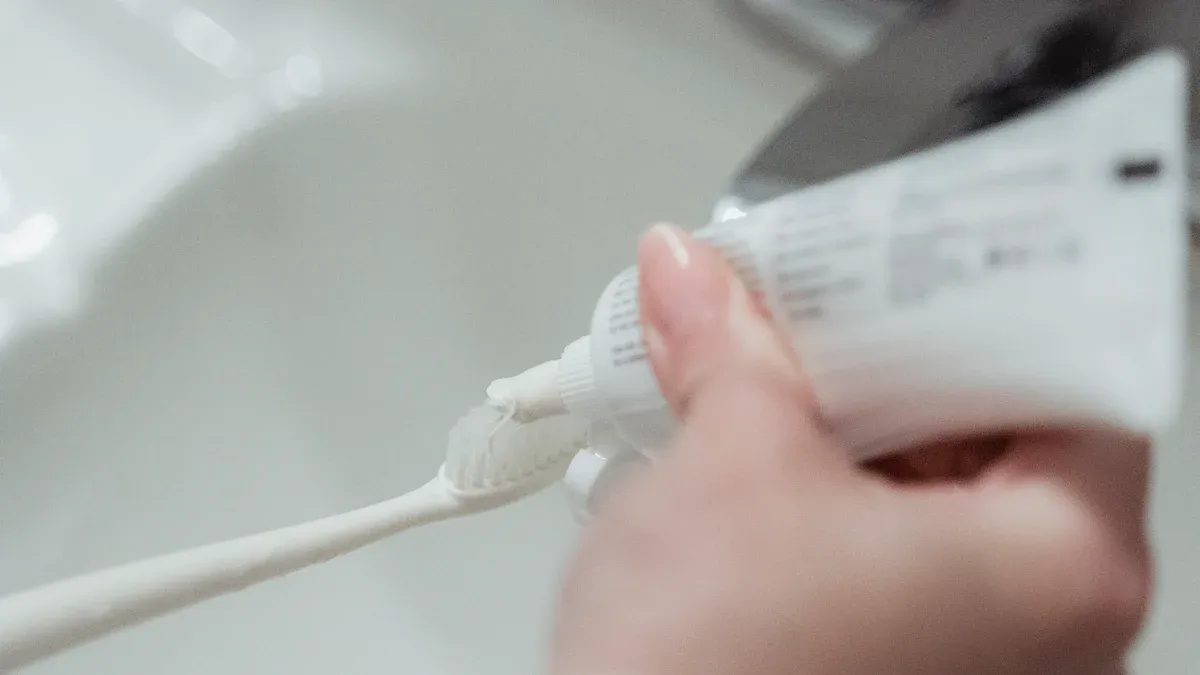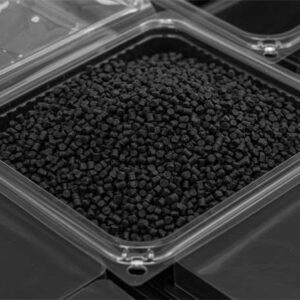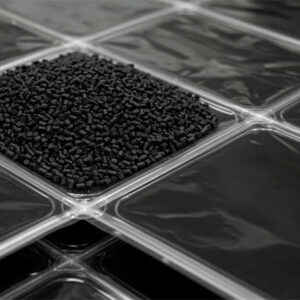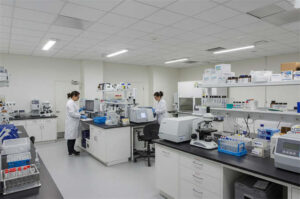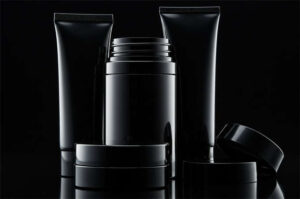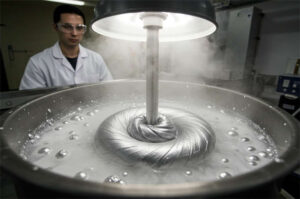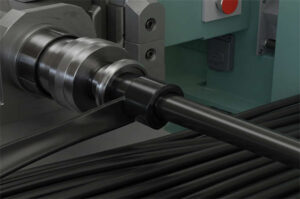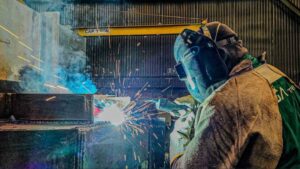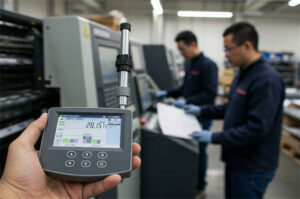Choosing ALUALUMINUM PASTE FOR SOLAR CELLS can help your solar cells work better and lower costs. You should look at purity, particle size, viscosity, and if the paste fits your cell type. These things affect how well the electricity flows and if the materials work together. The world market for aluminum paste in solar cell making was USD 2.5 billion in 2023, and Asia Pacific made the most money.
| Statistic / Segment | Data / Value |
|---|---|
| Global Market Size (2023) | USD 2.5 billion |
| Asia Pacific Revenue Share (2023) | ~50% |
| Application Market Share | Monocrystalline Cells: 60% |
Tip: Use these facts to stop common mistakes and help your solar cells work their best.
Key Takeaways
- Pick aluminum paste that fits your solar cell type. Make sure it works with your production process. This helps your cells work better and saves money.
- Look at important paste features like purity and particle size. Check viscosity and firing temperature too. These things help make good electrical contact. They also help your cells last longer.
- Try new paste in the lab first. Test it on small production lines before using it everywhere. This helps you find problems early. It also helps you get better results.
- Work with suppliers you trust. They should give you paste that is always the same. They should help you with technical problems. This keeps your production easy and steady.
- Do not make common mistakes. Do not forget to check if the paste matches your cells. Do not only think about price. Do not ignore how reliable the paste is. This keeps your solar cells working well and helps you earn more money.
Requirements
Cell Type
You need to match the aluminum paste to your solar cell technology. Each cell type has its own needs:
- Conventional, mono PERC, bifacial PERC, TOPCon, and heterojunction (HJT) cells all use aluminum paste, but each one needs a different formula.
- The paste must have the right viscosity, adhesion, wetting, and dispersion. These qualities help you print the paste smoothly and avoid problems like clogging or stickiness.
- For bifacial PERC cells, the aluminum paste goes on the back. It must work well with the silver paste on the front.
- The organic binders and additives in the paste change how well it prints and how efficient your cell becomes.
- You should choose a paste that matches your rear passivation film and co-firing process. This helps you get better efficiency and lower costs.
- Some pastes can etch the rear passivation film and make local aluminum-silicon contacts. This means you do not need a separate LCO step.
- Good control of the paste helps you avoid defects and get the best fill factor and passivation, especially at the edges.
Tip: Always check if the paste fits your cell type and process. This step can save you time and money.
Efficiency Goals
Your efficiency goals shape the technical details you need in your aluminum paste. If you want high efficiency, you must control the surface density of the paste and the firing temperature. For example, a surface density around 3.52 and a firing temperature near 840°C give the best results. These settings help you get a higher fill factor and better carrier lifetime. If you use too much paste, the fill factor drops. If you use too little, you may not get enough contact. Always aim for the right balance to reach your efficiency targets.
Production Scale
Think about how much you plan to produce. If you run a large factory, you need a paste that works well in high-speed printing and gives the same results every time. Small-scale production lets you test new formulas or make custom cells, but you still need a paste that is easy to handle and gives stable results. Choose a paste that matches your production needs so you can avoid waste and keep your process smooth.
ALUALUMINUM PASTE FOR SOLAR CELLS: Key Factors
Purity
You should check how pure your aluminum paste is. High purity means there are fewer bad elements inside. These bad elements can hurt how well your solar cell works. Impurities can make problems in the back contact layer. This lowers how much energy your solar cells make. Using ALUALUMINUM PASTE FOR SOLAR CELLS with high purity helps your cells last longer. It also helps them work better. Top companies use strict rules to keep impurity levels low. This matches what is best in the solar industry.
حجم الجسيمات
The size of aluminum particles in the paste is important. Most pastes have particles between 1 and 80 micrometers. The main particles in the back contact layer are about 3–5 micrometers. This size helps balance strength and electrical flow. If particles are too big, your cells might crack or bend when fired. If they are too small, you may not get a good back surface field. This can lower your cell’s power. Pick a paste with the right particle size to avoid these problems. This keeps your solar cells strong and efficient.
Viscosity
Viscosity shows how thick or thin the paste is. You want a paste that is not too runny or too thick. The right viscosity lets you print smooth lines. It stops the screen from clogging or getting messy. Good viscosity helps the paste stick to the cell. It also forms even layers. This makes your solar cells look better and work better. If the viscosity is wrong, you might waste material. You could also get poor electrical contact.
Surface Density
Surface density means how much aluminum goes on the cell’s surface. This changes how well the metal connects to the cell. It also affects how much power you get. More aluminum can lower contact resistance. This helps electricity flow better. But too much aluminum can make large spikes. These spikes can hurt the cell and lower its voltage. Too little aluminum means the contact might not be strong enough. You need to find the right balance.
| Surface Density Factor | Effect on Solar Cell |
|---|---|
| Higher aluminum content | Lower contact resistance, better ohmic contact |
| Too much aluminum | Large spikes, more recombination, lower voltage |
| Good glass frit and wettability | Better contact, higher efficiency |
Tip: Always measure and control surface density. This helps you get the best results from your ALUALUMINUM PASTE FOR SOLAR CELLS.
Firing Temperature
You must fire the paste at the right temperature. This helps you get the best performance. Most experts say about 750°C is best. If you fire at a lower temperature, contact resistance stays high. The metal does not form well. If you fire too hot, you can damage the cell. This increases recombination and lowers efficiency. The right firing temperature gives you strong contacts. It also helps your solar cells last longer.
| Firing Temperature (°C) | Result |
|---|---|
| Below 750 | High contact resistance, weak metal contact |
| Around 750 | Best balance, strong contact, good efficiency |
| Above 750 | More damage, higher recombination, lower efficiency |
Rheology
Rheology is how the paste flows and spreads. Good rheology helps you print fine lines and even layers. You want the paste to spread just enough to fill the screen. It should not run everywhere. Good adhesion, wetting, and dispersion are all part of rheology. These help you use less material and make better lines. You also get higher efficiency. If the paste does not wet the screen or cell well, you might get gaps or weak spots. If particles do not spread evenly, your cell might not work as well.
- Good adhesion keeps the paste on the cell during printing and firing.
- Wetting helps the paste cover the cell surface without leaving gaps.
- Dispersion makes sure particles spread out evenly. This helps every part of the cell work the same.
New ALUALUMINUM PASTE FOR SOLAR CELLS uses nano-sized particles and new additives. These improve rheology. They help you get better conductivity and longer-lasting solar panels. Many companies now use eco-friendly formulas. This makes the process safer for workers and the environment.
Note: Always follow safety rules when using aluminum paste. Wear gloves and work in a place with fresh air. Store chemicals safely. Many factories use greener solvents and recycling methods. This helps protect the environment.
Compatibility
Substrate Match
You have to pick ALUALUMINUM PASTE FOR SOLAR CELLS that fits your substrate. Each solar cell substrate, like p-type or n-type silicon, needs something special. If you use the wrong paste, your cell can lose more energy. This means your solar cell will not work as well. For n-type cells, you need a paste that does not hurt the passivation layer. The size of the local contact opening (LCO) is important too. A good match gives you strong ohmic contact and keeps your cell working well.
Tip: Always read the paste label to make sure it works with your substrate before you start making cells.
Metallization Process
Your metallization process tells you how to put on the paste and make contacts. You need to make good ohmic contact and keep energy loss low. Some pastes can hurt passivation layers, like AlOx or SiNx, if you do not control the process. For n-TOPCon cells, normal silver-aluminum pastes can make spikes that damage the passivation layer. This causes more energy loss and lower efficiency. Newer methods, like LECO, use special aluminum-free pastes. These pastes only etch where needed, so you get better contact resistance and higher open-circuit voltage. Heterojunction (HJT) cells need pastes that cure at low temperatures. This keeps the thin layers safe and contact resistance low. Every cell type and process needs its own paste formula.
- Pick a paste that fits your cell design.
- Watch the firing temperature to keep passivation layers safe.
- Use special pastes for advanced cells like HJT or IBC.
Firing-Through Suitability
You need to check if your paste can handle your firing process. Some pastes need high heat, while others work at lower heat. If you fire at the wrong temperature, you can hurt the cell or get weak contacts. For firing-through, the paste must break through the passivation layer just enough to make good contact, but not too much to cause harm. Always test your paste with your firing setup so you do not get bad results.
| Cell Type | Firing Needs | Paste Feature Needed |
|---|---|---|
| PERC | Standard firing | Good adhesion, right flow |
| n-TOPCon | Precise firing window | Low damage, strong contact |
| HJT | Low-temperature curing | Strong bond, low resistance |
Note: Matching your paste to your firing process helps your solar cells work better and last longer.
Supplier & Quality
Reputation
It is important to pick a supplier with a good reputation. You want a company that has worked in solar for many years. Five Star Materials has given aluminum paste to factories for over 15 years. Many people trust their products because they always work well. For example, a big solar panel company in California made their cells 2% better after using Five Star Materials’ paste. You can look at reviews, awards, and certificates to see which suppliers are the best. Good suppliers often work with top labs and follow strict rules from groups like the International Electrotechnical Commission (IEC).
Tip: Choose a supplier with a strong history. This helps you avoid trouble and get better results.
Technical Support
You need your supplier to give you good technical support. Good support helps you fix problems fast and keep your factory running. Five Star Materials has teams around the world to help with setup and fixing issues. Their experts teach your workers new skills through programs like ISRA VISION Academy. You can use special software like Connected Photovoltaics 4.0 to control quality on all your lines. The Central Recipe Tool lets you change settings quickly. EPROMI live software shows you real-time data and dashboards. This helps you find and fix problems right away. These tools make your work easier and stop delays. You can adjust your process and get the best from your aluminum paste.
- Teams around the world help with setup and fixing problems.
- Training keeps your workers learning new things.
- Software gives you control and helps you see what is happening.
Batch Consistency
Batch consistency means every shipment of عجينة الألومنيوم works the same. You want each batch to have the same purity, particle size, and thickness. Five Star Materials checks every batch with strict tests. Their labs test samples before sending them out to make sure the paste is right. A solar cell factory in Texas had no stops after switching to Five Star Materials because their batches were always the same. When batches are consistent, you avoid mistakes and your solar cells work better. You should ask your supplier for test results and certificates. This helps you know your paste will work well every time.
| Quality Factor | Why It Matters |
|---|---|
| Purity | Makes sure cells work well |
| حجم الجسيمات | Stops cracks and problems |
| Viscosity | Helps you print smoothly |
| Batch Consistency | Cuts down on waste and stops |
Note: Always ask for batch test results from your supplier. This keeps your factory safe and helps you reach your goals.
الاختبار
Lab Checks
You should always start by testing new عجينة الألومنيوم in the lab. Lab checks help you see if the paste meets your basic needs before you use it in your factory. You can measure viscosity, particle size, and purity with simple tools. You should also check how the paste prints on test wafers. Look for smooth lines and even coverage. Use a microscope to spot any cracks or gaps. You can test adhesion by using a tape test. Pull the tape off and see if the paste stays on the wafer. If you see problems, you can fix them before moving to bigger tests.
Tip: Lab checks save you time and money by catching problems early.
Pilot Runs
After lab checks, you should run pilot tests. Pilot runs use real production tools but on a smaller scale. This step helps you find problems that do not show up in the lab. You can use pilot lines that process up to 100 wafers per hour. Some lines can handle up to 1400 wafers per hour. You can optimize each tool and process step under real conditions. You should look for issues with printing, firing, or paste spreading. You can also do a gain-loss analysis to see where you lose power or efficiency. If you find a problem, you can change the process and test again. This helps you get better results before you start mass production.
| Aspect | Description |
|---|---|
| Role of Pilot Lines | Bridge gap between lab and mass production |
| Equipment & Capacity | Tools process up to 100–1400 wafers/hour |
| Process Optimization | Fine-tune each step under real conditions |
| Loss Analysis | Find where you lose power or efficiency |
| Material Issues | Spot problems with paste during scale-up |
| Iterative Fabrication | Make several batches to improve results |
| Outcome | Solve problems and boost efficiency (e.g., up to 19.21% in second round) |
Performance Metrics
You need to measure how well the paste works. Use clear metrics to judge performance. Electrical efficiency shows how much power your cell makes. A strong back surface field can give you up to 0.1% more efficiency. Wafer bowing tells you if the paste keeps thin wafers from cracking. Good paste works even with wafers as thin as 150μm. Adhesion strength is also key. You want the paste to stay on the wafer, even in heat and humidity. You can use a tape test or measure peel force. Look for adhesion above 3N/cm.
| Performance Metric | Description | Method/Value |
|---|---|---|
| Electrical Efficiency | Power gain from strong back surface field | Up to ~0.1% gain |
| Wafer Bowing | Prevents cracks in thin wafers | Works down to 150μm thickness |
| Adhesion Strength | Paste stays on under stress | >3N/cm; tape/peel test |
Note: Always track these metrics to make sure your process gives you the best results.
Mistakes to Avoid
Ignoring Compatibility
You should always check if the aluminum paste fits your solar cell type and process. If you skip this step, the paste might not stick well. It can also make weak electrical contact. Your solar cells could lose power or even break during production. For example, using paste for p-type cells on n-type cells is a problem. This mistake can cause more recombination losses. You will get less power and waste materials. Always read the product label and technical sheets before starting. If you are not sure, ask your supplier for help. Making sure the paste matches helps you avoid mistakes and keeps your factory running well.
Tip: Try a small batch first to see if the paste works with your cell design.
Overlooking Cost vs. Performance
You need to think about both cost and performance when picking aluminum paste. If you only choose the cheapest paste, you might pay more later. Good aluminum paste helps your cells work better by making them reflect more light and conduct electricity well. It also helps stop corrosion. Reports show that not balancing cost and quality can make your costs go up and your products worse. Bad paste choices lower efficiency and make you spend more money. This hurts your profits over time. You should check your suppliers and compare pastes for cost, quality, and how well they work. Doing this helps your solar cell business stay strong for a long time.
| Factor | Impact on Profitability |
|---|---|
| Low-cost, low-quality | Higher costs, lower efficiency |
| Balanced choice | Better performance, more profit |
Neglecting Reliability
Reliability is important in every part of making solar cells. If you forget about reliability, you might get more mistakes and fewer good cells. Bad paste can make each batch different, so your cells do not all work the same. You should ask your supplier for test results and certificates for each batch. Reliable paste gives you steady results and fewer stops in production. This helps you reach your goals and give your customers good products.
Note: Using reliable paste helps you succeed for a long time and keeps your good reputation.
You can make your solar cells work better by picking the right ALUALUMINUM PASTE FOR SOLAR CELLS. Always look at purity, particle size, and viscosity. Make sure the paste matches your cell type. Test the paste in the lab first. Try it on pilot lines before big production. Work with suppliers you trust. Good suppliers give strong technical help and send batches that are always the same. Check your process by:
- Using solvents to get the right thickness and smooth lines
- Setting the snap-off distance right when screen printing
- Adjusting metal content for good contact
Take time to look at how you pick your paste now. Even small changes can help your solar cells work better and last longer.
FAQ
What is ALUALUMINUM PASTE FOR SOLAR CELLS?
ALUALUMINUM PASTE FOR SOLAR CELLS is a special material. People use it to make electrical contacts on solar cells. It helps solar cells work better and last longer. You can learn more on the U.S. Department of Energy website.
Can you use ALUALUMINUM PASTE FOR perovskite solar cell?
You can use ALUALUMINUM PASTE FOR perovskite solar cell. The paste must match the substrate and firing process. Always ask your supplier and read technical sheets to check if it fits.
How do you test ALUALUMINUM PASTE FOR home solar cell?
You test ALUALUMINUM PASTE FOR home solar cell by printing it on a sample wafer. Fire it at the right temperature. Measure how much electricity it makes. Use a tape test to see if the paste sticks well.
Why does particle size matter in ALUALUMINUM PASTE FOR solar cell and photovoltaic cell?
Particle size changes how the paste prints and how strong the contact is. Smaller particles can help electricity flow better. Very tiny particles might cause cracks. Pick the right size for your solar cell type.
Where can you find reliable suppliers for ALUALUMINUM PASTE FOR solar cell solar cell?
You can find good suppliers by looking at reviews and certifications. Check groups like SEIA (Solar Energy Industries Association). Trusted suppliers give you batches that are always the same and help you with technical support.

